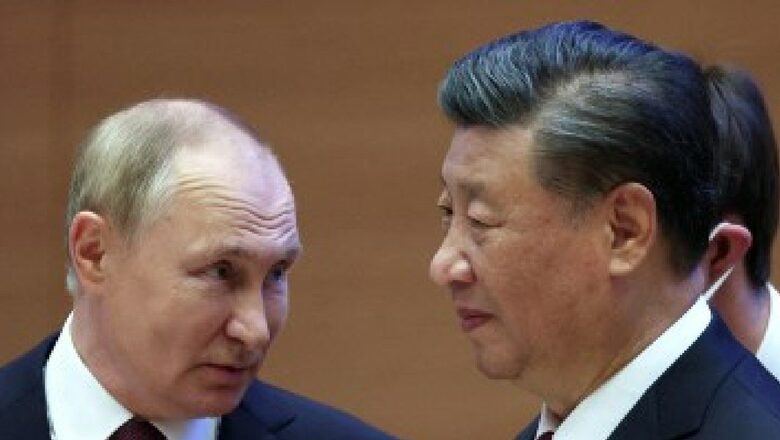
views
While global attention is focussing on the Russia-Ukraine crisis and an escalation of conflict between China-Taiwan in recent months, one issue which has not received much attention from policy analysts is the quiet inroads of China to the so-called “heartland”, i.e., Central Asia, also considered as the “soft underbelly” of Russia. This issue is gaining importance in recent years as the so-called friends, China and Russia, despite having somewhat cordial relations, compete to have a predominant role in Central Asia. One can portray the rivalry between Moscow and Beijing as “Great Game 3.0”.
In this background, one must locate China-Central Asia geopolitical interaction. This relation is partly guided by China’s traditional “Middle Kingdom complex’ geopolitical doctrine aimed at bringing the Central Asian space under its spheres of influence as part of its “peripheral policy” to strengthen its presence in this part of the world and to contain any other external powers which may pose a direct threat to its geopolitical interest.
In this theoretical construct, China has been pursuing its strategic diplomacy with the Central Asian region over the years by harnessing the oil and gas of this region necessary to sustain its economic development. In the post-1991 phase, Beijing took steps to engage Russia to ensure strategic equilibrium in this space. China did try to resolve the border disputes inherited from the Soviet past in the post-1994 phase. In this regard, the initiation of the Shanghai Five, which later took the shape of the Shanghai Cooperation Organisation (SCO), as a forum to settle border disputes resulted in the emergence of an institutional forum for China’s engagement with the Central Asian countries.
It may be recalled here that China shares a long historical relationship with the Central Asian countries through Silk Road. The Chinese Communist Party (CCP) in the post-1991 phase tried to extend its sphere of influence in this region using a historical Chinese rule as a pretext. One major objective of the CCP in the post-1991 era was to use Central Asia as an important strategic corridor to further Chinese imperial ambitions in Europe and other parts of post-Soviet Eurasia.
Post 2001 saw a new geopolitical realignment of Central Asia. The entry of the United States, considered a strong beta noire of China, propped up new geopolitical security challenges in Central Asia. The presence of the US bases in the post-2001 years to fight radical and terrorist forces in Afghanistan has also alarmed the Chinese authorities to a considerable extent. It is in this context one can see a propping up of a Cold War syndrome in the framework of the Zero-Sum game between Russia and China versus the US in the Central Asian space. At the same time, one can notice a creeping expansion of China in Central Asia, especially in energy structure and other areas of the economy.
Taking advantage of the porous border, one can notice the growing movement of the Chinese population to neighbouring countries like Kazakhstan, Kyrgyzstan and Tajikistan and taking over land there. By illegal transfer of lands to China in the name of the settlement of border disputes, both mineral-rich lands and pasture lands were given to China. This generated a sense of uneasiness among the local population. For instance, the settlement of border disputes in the Eastern part of Kazakhstan, the Pamir and Gorno Badakhshan region of Tajikistan and the Southern part of Kyrgyzstan bordering China drew massive protest among the local population calling the signing of the treaties prejudicial to the national interest of respective three Central Asian countries. Some of these protests against China’s land grab activities are also appearing in Central Asia. The massive protest erupted in Kazakhstan over land law in 2016, which intends to benefit China a lot by way of granting lands to Chinese farmers under the grab of lease resulted in its cancellation.
A study titled ‘Mapping Patterns Of Dissent In Eurasia: Introducing Central Asia’, published by a think-tank Oxus Society, highlights that around “57 protests took place against China in Kazakhstan alone, in Kyrgyzstan 41 protests from January 2018 to August 2020” (PP.4 and 7). Because of the massive public outcry, China has somewhat slowed down its expansionist projects in these three countries of Central Asia. For instance, as reported in Kyrgyzstan in February 2020, China was forced to cancel a joint project involving around 200 hectares of land in the strategically important Naryn region after the local protest. In Tajikistan, similar protest against China is a common phenomenon. There is a growing perception among the Tajik people that China may take over not only land but also precious minerals such as gold, lithium, lead and copper.
One may recall that in 2013 China launched its ambitious One Belt and One Road (OBOR) in Astana, hoping to bring the entire Central Asian space under its sphere of influence. As stated by China’s President Xi Jinping in his address to the opening of the OBOR Summit, “We hope to work with these countries to strengthen trust, friendship and cooperation, and promote common development and prosperity so as to bring benefits to our people”. However, looking at the Central Asian people’s experience over the years, there appears to be a great deal of resentment among the Central Asian people against China.
One of the worst consequences of the OBOR currently the Central Asian countries are facing is in terms of ecological catastrophe. In recent years, China has been carrying out large-scale industrialisation projects in its Xinjiang province, which has had a greater consequence in terms of water flow to Kazakhstan. In this regard, two major rivers, Ili and Irtysh, which flow from Xinjiang to Kazakhstan, are the major bone of contention between China and Kazakhstan. Because of the irregular flow of water to Kazakhstan from these two rivers, the agricultural sector is the worst affected, along with the drying up of Lake Balkhash of Kazakhstan. This, in turn, is affecting not only food production but also uprooting the local population.
Another contentious issue creating resentment in Kazakhstan is that there are allegations as studies suggest that China is shifting its polluting industries to Kazakhstan. This is, in a way, having an adverse impact on local ecology. It is a fact that many of the heavy industries, mines and energy blocs that China is managing in Central Asia do not follow international environmental norms and standards. These countries are also poorly equipped to negotiate with China on equal terms with regard to the protection of local ecology. Already Central Asia is facing environmental disasters from the Soviet past, and China’s reluctance to follow environmental norms while initiating projects to protect local ecology is accentuating the environmental threat. In the long run, this will pose a serious threat to the ecology of Central Asia. Some of the Chinese connectivity projects under the OBOR framework through Kazakhstan and the China-Kyrgyzstan-Uzbekistan rail projects facilitate connectivity but, at the same time, will have a greater ecological catastrophe.
The third arena where China is posing a threat to the Central Asian countries is in the reams of “debt diplomacy”. In fact, China consistently provides soft loans to Central Asian countries. However, over the years, one witnessed that by gradually offering loans, China is crippling Central Asian countries. Kyrgyzstan and Tajikistan are the two countries that are being adversely affected by the Chinese loan and are in a highly vulnerable position. On the other hand, China is using soft loans as a geopolitical tool to get a preponderance in the Central Asian geopolitical structure, whose long-term goal is to bring this landmass under its sphere of influence. A report published by a leading Think Tank, Carnegie Moscow, written by Temur Umarov, titled ‘China Looms Large in Central Asia’, highlights the debt problem the Central Asian countries are confronting from China. In this regard, the report by Umarov highlights, “Turkmenistan’s debt ratio to China as per its GDP is 16.9 per cent, in case of Uzbekistan’s GDP, the ratio is 16 per cent, in the case of Kazakhstan’s GDP, considered to be the largest trading partner of China in Central Asia, is around 6.5 per cent”.
Similarly, another study carried out by Sarah Lain titled ‘The Potential and Pitfalls of Connectivity along the Silk Road Economic Belt’, in the book ‘China’s Belt and Road Initiative and its impact in Central Asia’, highlights that for Kyrgyzstan the total debt to China is “38.1 per cent and for Tajikistan, the figure stood at 59 per cent of their total external debt in 2016. The debt by the Central Asian countries to China will increase over the years in the aftermath of the Covid-19 pandemic crisis as the Central Asian economies are slowing down a little bit. Analysts believe that the Central Asian countries may be the next victim of China’s debt diplomacy. The Chinese investment in Central Asia is also not benefitting the local youths in terms of employment opportunities. Despite provisions that the Chinese have to employ the local people in the industrial sectors, one witness that the Chinese companies are hiring Chinese people and leaving local people in a lurch for a job. As a result, large sections of Central Asians, particularly from Tajikistan, Kyrgyzstan and Uzbekistan, are going to Russia for a job. However, Russia’s recent war with Ukraine is creating difficulties for Central Asians in terms of employment opportunities in Russia. What one witnesses due to the large-scale employment of the Chinese population in Central Asia is a growing resentment among the locals as they are being denied job opportunity.
It is intriguing that China is opening a number of Confucius Centres in Central Asia to expand its cultural influence through which it can strengthen its geopolitical leverage. It has been observed that most of the Central Asian countries now have branches of this Confucius Centres. The basic objective of this institute is to train young minds and teach them the Chinese language. Even it has been observed that Confucius Centres are emerging as a tool of geopolitical influence in different parts of the world. Central Asian youths are attracted to the Chinese language as they think there are better job opportunities. It has been observed that China is also providing a lot of aid to local schools in Central Asia in a significant way for popularising Chinese culture. In the last virtual Summit to celebrate 30 years of Diplomatic relationship between China and Central Asia, Chinese President Xi Jinping stated in January 2022, “with priority on opening Confucius Institutes and Confucius Classrooms…”
If this trend continues for a few more years in Central Asia, then the day is not far when there will be a cultural hegemonisation of China in Central Asia. It has been reported that Kazakhstan president Kassym-Jomart Tokayev is being trained in the Chinese language. The same is also the case with Kyrgyzstan President Sadyr Japarov who has a deep Chinese connection. However, the Central Asian political elite are unaware or not interested in knowing the negative fallout of Chinese cultural expansionism. In the long run, the way Chinese language and culture are spreading in central Asia, it appears that the Central Asian native culture will soon be relegated to a secondary position. This will have a much deeper socio-cultural consequence for the respective Central Asian countries.
On the geopolitical front, after OBOR, China has created another institutional body along with SCO to bring Central Asian countries under its sphere of influence. This body, known as “China plus Central Asia”, was created when the Covid pandemic was at its peak in October 2020. In this regard, it needs to be underlined that the basic objective of China is to strengthen this body through which it can strategise its foreign policy in a well-calibrated manner in this region. China’s policymakers knew that the future prosperity of China’s OBOR project lies in bringing Central Asian space under its control. As discussed above, some of the major connectivity projects with Europe as discussed above are passing through Central Asia. Already, China has displaced Russia as the key player in the Central Asian energy sector. Besides, China has also got a preponderance in rare earth metals of this region, having a vast future potentiality especially in its use in the renewable energy sector. Over the years, the trade relations between China and Central Asia reached $US 40 billion, as per Xinhua’s reporting. However, it is primarily skewed in favour of China. This gives China leverage in controlling Central Asian geopolitics.
Even in the latest China plus Central Asia Foreign Ministers’ Summit in Nur Otan in June 2022, Chinese Foreign Minister Wang Yi outlined a strategy to bring Central Asian countries. Though “10 points programme” that Yi outlined aimed at bringing overall economic cooperation with Central Asia, the real motive is to bring this space under China’s control in the long run.
A critical look at China’s relations with Central Asia demonstrates that it is an unequal geopolitical partnership. Over the years, China is taking advantage of both the geopolitical fluidity and Central Asian countries’ vulnerability due to the transitional processes these countries are confronting in the post-1991 phase. It is also trying to make this region as its “periphery’ thus bringing it under its control. This resulted in the weakening position of Moscow in geopolitical bargaining. However, it is a fact that both China and Russia are at loggerheads with each other in the Central Asian geopolitical space. In this condition, what is best suited for Central Asian countries is to pursue a genuine multi-vectoral foreign policy which will somewhat lessen their dependence on China.
The author is Assistant Professor at the School of International Studies, JNU. The views expressed in this article are those of the author and do not represent the stand of this publication.
Read all the Latest Opinion News and Breaking News here


















Comments
0 comment